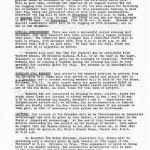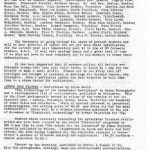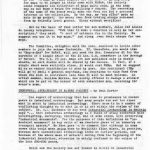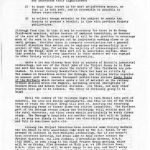Page 1
As the Newsletter goes to press we learn that of the Borough has granted HADAS an extension on the Church End site until March 1974. This is good news, although the vagaries of an English winter may cut digging time considerably. This is all the more reason for welcoming all volunteers that can come to help at this excavation, bearing in mind that fog, heavy and persistent rain or snow will cause cancellation. Otherwise the dig will be open on Saturdays from 2.00p.m. to dusk and on Sundays from 10.00a.m. to dusk. For those of you who are free mid-week it will be open on Wednesdays from 10.30a.m. to dusk. Because of special commitments there will be no digging on 17 November nor on 1st or 2nd December.
Christmas Party
Special announcement. There was such a successful social evening last December, that many requests have been received for a repeat occasion this year. The committee have arranged that a Christmas Party will be held on Friday 14 December 1973 from 7.30 to 10.00p.m. at 166 Station Road, NW4 as last year. We hope that the food, drink and games will be as enjoyable as before.
Tickets will cost £0.50 (30p for juniors) and be obtainable from Richard Deacon or at the door on the night. Transport to and from the party can be arranged if requested. Dorothy Newbury will be running a Tombola during the evening and will be very grateful for suitable gifts for this.
Brockley Hill Weekend
Last winter’s two weekend work-ins on pottery from the Brockley Hill Roman kiln site proved so useful and popular that on 1st/2nd December next a further working week end will be held at the Tea House, Northway, NW11. We must record again how greatly indebted HADAS is to Mr John Enderby and the Hampstead Garden Suburb Institute for the use of the Tea House, an ideal venue for this kind of project.
Members who are interested in helping to sort, collate, index and study these finds are invited to attend between 10 and 1 and 2.30 and 5.30 on both Saturday and Sunday 1st/2nd December. Experienced and inexperienced workers will be welcome, but as accommodation is limited would you kindly inform the Hon. Secretary beforehand if you propose to take part, so that if necessary a rota system can be introduced.
Lectures
Our lecture on 4th December will be on “Developments in Industrial Archaeology” and will be given by Paul Carter, a dedicated worker in the field of Industrial Archaeology. At the end of this newsletter is an article describing his new project in the Borough of Barnet. Once again we regret that the Hendon Library is not able to house us, so that this lecture will be given at St. Mary’s Church House, Church End, NW4 at 8.15p.m.
On 6 December HADAS Chairman, Councillor B. A. Jarman will be presiding over a lecture given by Lady Wheeler on “The Egypt of the Pharaohs” at 8.15. Entrance is free. This engagement is noted as being held in the Hendon Library, but alternative arrangements will be made if the building is not yet available for public use.
Exhibition
At Church Farm House Museum from 20 October until 25 November, there will be on show “Police Uniforms of the World”. Part of a private collection, this material has been featured on television in several countries and ranges from very early material such as uniforms of Bow Street Runners and “Peelers”, manacles, leg-irons from the eighteenth century down to the more recent uniforms of British and foreign police forces.
Page 2
News from HADAS
Recently HADAS passed a landmark in its history. We acquired our 200th member. Membership today is the highest we have ever had. The Society offers a warm welcome to all who have joined since last May, and hopes that they will enjoy their membership and find many opportunities for taking part in the Society’s various activities. New members are: —
Mrs. Janet Abrey, Hendon; Michael Bird, Finchley; John Bowman, Edgware; P. J. J. Corrigan, Edgware; Albert Dean, Hendon; Mr & Mrs de Launay, Edgware; Christopher Doe, Hendon; Angela Fine, Hendon; Francesca Frachi, Golders Green; Mr. & Mrs. Hadley, Kenton; Miss Una Hall, Hendon; Miss Barbara Hobden, Finchley; Charles and Mark Howard, Hampstead; Miss Ann Kimber, North Finchley; Miss Rebecca Klein, Hendon, Hendon; Mrs. Sophia Kroll, Golders Green; Jonathan Jones, Woodside Park; A. J. Lamport, Hendon; Gerard Leonard, Cricklewood; Dr. Ruth Lever, Elstree; Mrs. Lissack, Garden Suburb; Miss Linda McKiernan, Hendon; Anthony Maddison, Hendon; Miss Nina Mallett, Hendon; Jonathan Martin, Hendon; Dermot Musgrove, Finchley; Miss Hilary Nicholls, N2; Miss Fiona Plumley, Barnet; Clive Smith, Hendon; Mrs. A. Smullen, Hendon; Miss C. Stavrou, Balham; Arther Stutt, Golders Green; Miss Dorothy Thomas, Finchley; Mr. A. V. Turner, Garden Suburb.
The Treasurer is going through the lists of present members and will be most grateful if anyone who has not yet paid their subscription for the current year will immediately post it to him. It will save postage money and a great deal of time if he does not have to send reminders out to all members to renew their subscriptions.
It has been suggested that if members collect all British and Overseas stamps that come into their hands, it would be a way for the Society to make a small profit. Stamps can be carefully torn off envelopes and brought to lectures or meetings for Richard Deacon, the Treasurer. When a sufficient number has been acquired he will take them to a stamp dealer for realisation.
Autumn Book Feature
Contributed by Celia Gould.
“The Archaeology of the Industrial Revolution” Brian Bracegirdle and a distinguished list of contributors, published by Heinemann. This is the first photographic record in colour of the remains of our industrial past — canals, railways, docks, mines, factories and hundreds of other sites and artefacts. More of special interest to industrial archaeologists, the selling price £6.50 may all but the most enthusiastic! There will be a Paladin paperback published and the end of November on “Industrial Archaeology” by Arthur Raistrick for 75p.
Members whose curiosity concerning the mysterious Etruscan civilisation may have been aroused by the recent “Chronicle” programme on BBC2 may like to read “The Search for the Etruscans” by James Wellard, recently published by Nelson. Illustrated in black and white and full colour, the book brings together all the available evidence to reconstruct a picture of Etruscan society and achievement. (£4.50 hardback — Sphere paperback £1.95)
“Petra” by Ian Browning, published by Chatto and Windus at £5. With 200 photographs, drawings, maps and archaeological reconstructions, this book aims to offer general readers and archaeologists an introduction to one of the most remarkable cities of the ancient world.
The Illustrated Paladin paperback edition of V. Gordon Child’s “The Dawn of European civilisation” has been published at £1.
For a fascinating account of the Aztecs try “The Aztecs” by Nigel Davies (Published by Macmillan) or “The Ancient Sun Kingdoms of the Americas” by Victor Von Hagen.
Page 3
BUY-A-MAP for HADAS
The October Newsletter described the problem the Society faces in completing its collection of 25 ins. O.S. for maps of the Borough. A Finchley member, Margaret Musgrove, reacted quickly — and generously — to the emergency. She wrote:
I see the Society needs 25 ins. O.S. maps. I enclose a cheque for you to buy on my behalf a map of your choice for the Society to keep, with — if you think it a good idea — my name at recorded on it. Perhaps if other members had the idea of giving money for maps to be lodged in their name with HADAS, the Society could complete its collection of maps quite soon, in the same way as one buys a brick for rebuilding a church. The recording of the name of the donor would make one feel one had a personal interest in the collection. By the way, my “map offer” made no whole in my pocket; the money came from trading stamps redeemed by my friendly local grocer. Glory without sacrifice!
Hot on the heels of this letter two new members, Jules and Louise de Launay telephoned. “We’d like to make a donation as well as our subscription,” they said.”A sort of entrance fee to the Society. We suggest you use it to buy maps.” And along came the cheque for two maps.
The Committee, delighted with the idea, resolved to invite other members to join the scheme forthwith. If, therefore, you would like to “BUY-A-MAP” for HADAS, will you send the Hon. Treasurer £1 for the purchase of a single sheet of the 25 ins. O.S. somewhere in the Borough of Barnet. The O.S. 25 ins. maps are now published only in double sheets, so each double will be shared by two donors. In fact, if a single sheet were available alone, it would cost 82 1/2 p. But we suggest £1 as an easier contribution to send by post. The additional 17 1/2p will go to swell a general map-fund, and donations to this fund from those who wish to contribute less than £1 will be most welcome. An artist member, William Morris, has kindly offered to design a sticker which can be put on the corner of each subscribed map, recording the donor’s name.
Industrial Archaeology in Barnet Project
by Paul Carter.
One aspect of archaeology that has come to prominence in recent years is industrial archaeology. But many people are not too clear what is meant by industrial archaeology. There seemed to be a number of conflicting thoughts as to what is or is not within the realms of the subject. Dr. R. A. Buchanan in his book “Industrial Archaeology in Britain” says “… that industrial archaeology is a field of study concerned with investigating, surveying, recording, and in some cases, with preserving “industrial monuments”. For the purposes of this definition an “industrial monument” is any relic of an obsolete phase of an industry or transport system.” He then goes on to comment that although in some cases this could mean going back to Neolithic flint mines, in practice, and because of the sheer mass of material dating from the beginning of the Industrial Revolution, attention is mainly confined to the relics of the last 200-250 years.
Until now the Society has not looked in detail at industrial archaeology in Barnet, although a certain amount has been done, mainly by members of the Research Committee. Now the Society is to undertake, under the joint direction of two of our members, Alec Jeakins and Paul Carter, a systematic investigation of this aspect of the Borough’s archaeology. The Project which will be carried out over the next two to three years, has three main aims:
Page 4
1) to locate and compile an adequate record of the industrial archaeological remains within the London Borough of Barnet, and to understand their significance;
2) to house this record in the most satisfactory manner, so that it is both safe, and as accessible as possible to future researchers;
3) to collect enough material on the subject to enable the Society to produce a booklet, in line with previous Society publications.
Although from time to time it may be necessary for there to be Group field-work sessions, either because of imminent demolition, or because of the size of the feature, normally it will be the practice to encourage much of the work to be carried out by individuals working alone or in small groups. Provided there is adequate co-ordination and a general overall direction this method can be employed very successfully in a project of this type, for unlike the majority of archaeological activities in the field, work of this sort can be undertaken any time, when time permits. This is very important to those members who are engaged in other Society activities, such as excavation.
Quite a lot has already been done on aspects of Barnet’s industrial archaeology, and one of the first jobs of the Project Group is to find out what has been done and where the results of this fieldwork are published. In recent Society Newsletters there has been an article by Ted Sammes on Milestones within the Borough, and a William Morris reported an unusual post box. London Transport publications include “Sixty Years of the Northern” which includes quite a lot of material on the railway between Golders Green and Edgware, including several photographs of Golders Green and Hendon Central stations. All these, and many other sources have got to be indexed. The Group is obviously going to be busy!
Until the coming of the railways began to turn Barnet into part of Suburbia, the area was mainly agricultural, and this is one of the first areas of study the Project Group will look at, locating and recording the remaining farms or former farms and related industries. The Northern part of the Borough around Arkley and Totteridge still retains much of its rural character, and these areas should particularly be worth closer study. The Borough’s hospitals are another aspect that will be looked at, as many are likely to have their own electricity generating plant, and this is sometimes quite old.
Already the Project Directors have contacted some Society members who are known to have undertaken some work in the I.A. field, or expressed an interest in Post-Medieval Archaeology, but if you haven’t been contacted directly, but would like to help either contact the Project Directors, via Alec Jeakins, or come along to the first Project Group meeting, which will be on Friday 23 November at 8.00p.m. at 166, Station Road, NW4. Alec and Paul will be most happy to see you, and don’t worry if you think you know nothing about this aspect of archaeology – you will find out you will be able to help.





